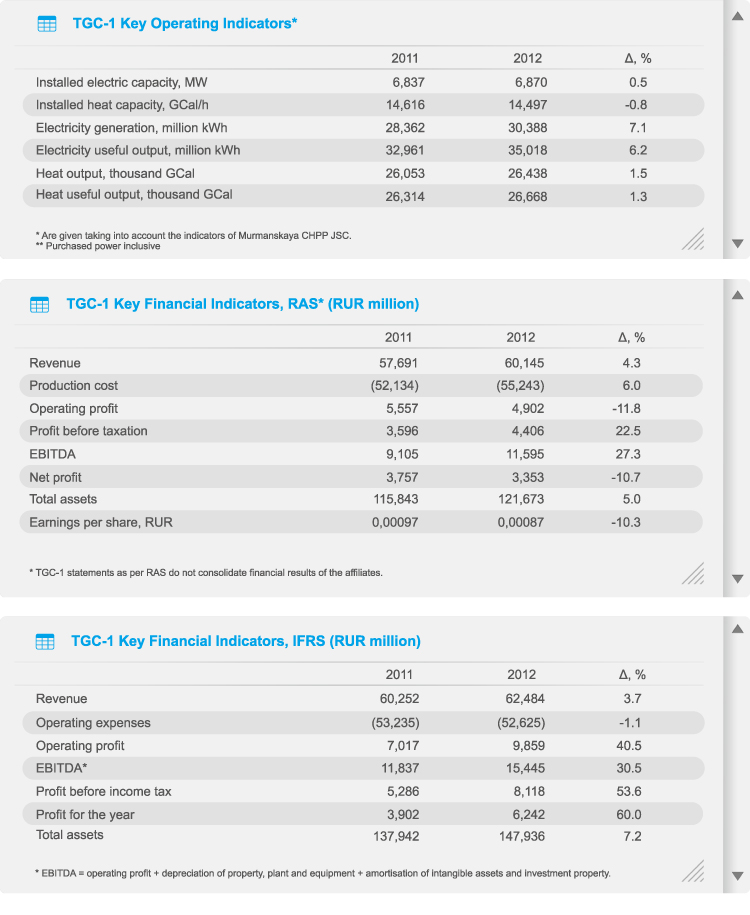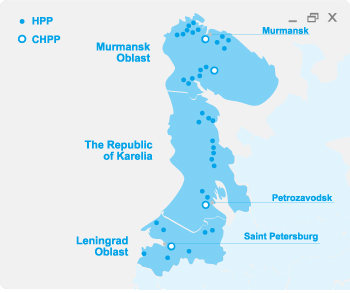Key Indicators

Overview
Territorial Generating Company No. 1 JSC is the leading producer of electricity and heat in the North-West region of Russia.
TGC-1 was founded in 2005 in the course of reforming of the electric energy industry of Russia, and nowadays the Company incorporates generating enterprises from the Baltic Sea to the Barents Sea. TGC-1 generating assets comprise 55 electric power plants of various types in four subjects of the Russian Federation such as Saint Petersburg, the Republic of Karelia, and Leningrad Oblast and Murmansk Oblast.
 Generated electricity is delivered to the domestic wholesale electricity and capacity market and is also exported to Finland and Norway. TGC-1 is a strategic supplier of heating in Saint Petersburg, Petrozavodsk, Murmansk, Kirovsk in Leningrad Oblast, and Apatity in Murmansk Oblast.
Generated electricity is delivered to the domestic wholesale electricity and capacity market and is also exported to Finland and Norway. TGC-1 is a strategic supplier of heating in Saint Petersburg, Petrozavodsk, Murmansk, Kirovsk in Leningrad Oblast, and Apatity in Murmansk Oblast.
TGC-1's structure includes the following affiliates: Murmanskaya CHPP JSC (energy supply to Murmansk and surrounding areas; a 90.34 % share in the authorized capital), Hibiny Heat Company JSC (reformation of heat supply in the Apatity-and-Kirovsk region; a 50 % share in the authorized capital), St. Petersburg Heating Grid JSC (an association of the heating grids within the area of the Company's CHPP operations; a 74.99 % share in the authorized capital), and the affiliated company TGC-1 – Service LLC (specialized repair and maintenance enterprise; a 26 % share in the authorized capital).
TGC-1 is part of the Gazprom Group. Gazprom's generating assets are consolidated in the balance of the special-purpose affiliate Gazprom Energoholding, established within the framework of the Gazprom Strategy implementation in the electric energy industry. This allows an effective management system based on unified corporate standards to be created. The Group consolidates the controlling stakes of Mosenergo, OGK-2, and TGC-1 through Gazprom Energoholding. Gazprom is the largest owner of generating assets in Russia and one of the top ten power producers in Europe.

The principal shareholders of TGC-1 are:
- Gazprom Energoholding LLC with 51.79 % of shares, and
- Fortum Power and Heat Oy with 25.66 % of shares.
TGC-1 shares are traded on Moscow Exchange.
The second biggest shareholder, Fortum Power and Heat Oy, is Scandinavia's leading energy concern, with the highest standards of business conduct. It makes a valuable contribution to the enhancement of the Company's management efficiency.
Thus, operating environmentally responsible production and implementing an innovation social policy based upon international standards of business conduct, TGC-1 is striving to take the leading position on the energy market, be a reliable partner for investors, take care of shareholders' interests, and satisfy customers' highest requirements.
Company's Organisational Structure

January
The Pervomayskaya CHPP consisting of two 180 MW CCGT-units began supplying capacity to the wholesale electricity and capacity market under capacity supply agreements.
A meeting between the Company's management and the Industrial Power Engineering Foundation of Finland took place at TGC-1's the Yuzhnaya CHPP in Saint Petersburg.

Members of the Government of Saint Petersburg visited the construction of TGC-1's CCGT unit at the Pravoberezhnaya CHPP.
A meeting was held between representatives from Finland, Norway and Russia on the joint management of Lake Inari's water resources.

TGC-1 successfully completed the placement of a 10-year bond issue series 04 on MICEX-RTS Stock Exchange.
TGC-1 specialists together with representatives from Estonia held large-scale training sessions on emergency prevention at the Narvskaya HPP.
The Company was named best pass-holder by Vodokanal of Saint Petersburg in the 'Crystal Drop' competition.

115 years ago, operations started at the oldest power station in Russia, Electric Power Station no. 2 of the Central CHPP, which forms part of TGC-1's power in Saint Petersburg.

The 'Power Hour' project for children in Saint Petersburg and Leningrad Oblast commenced, run by TGC-1 together with the interactive scientific and entertainment center 'Umnikum'.
An inter-regional competition for TGC-1's thermal power station specialists was held in Saint Petersburg.
A press conference on Gazprom's Strategy in Electric Power was held at Gazprom's central office.
TGC-1's Lean Production Academy began operation.

TGC-1's Annual General Meeting of Shareholders took place.

Test trials of a new 30 MW hydroelectric units were completed at TGC-1's Lesogorskaya HPP.
The development of hydropower generation was discussed by representatives from Russia and Argentina at the Vuoksa HPPs Cascade.

TGC-1 held the testing and commissioning of the new 450 MW CCGT unit at the Pravoberezhnaya CHPP.
Operation was stopped at the Matkozhnenskaya HPP of the Vyg HPPs Cascade as a result of natural hazards.

Reconstruction of hydroelectric unit no. 3 was completed at the Lesogorskaya HPP and new equipment with a capacity of 30 MW was brought into operation.
The annual competition for operating personnel from all TGC-1 HPPs was held in Murmashi settlement.
Employees of the Matkozhnenskaya HPP and Vyg HPPs Cascade were awarded with honorary certificates from the Ministry of Emergency Situations in Karelia for their participation in the response to the disaster in the Belomorsky District.

Following successful testing, TGC-1 resumed operation of hydroelectric unit no. 1 at the Matkozhnenskaya HPP. The head of the Republic of Karelia presented a letter of gratitude to TGC-1 for their active participation in the disaster response in the Belomorsky District.

The ceremonial commissioning of the 450 MW CCGT unit was held at the Pravoberezhnaya CHPP in Saint Petersburg.
Large-scale reconstruction of the Iovskaya HPP began, which is part of TGC-1's investment programme in Murmansk Oblast. The first of two hydroelectric stations was removed.

Saint Petersburg's annual Christmas Fair opened with partnership of TGC-1, as is tradition.
After passing comprehensive testing, the last of the modernized hydroelectric units of the Svetogorskaya HPP at Vuoksa HPPs Cascade was put into operation.















